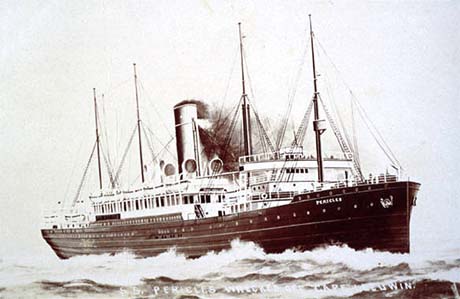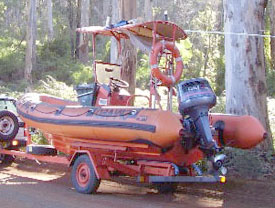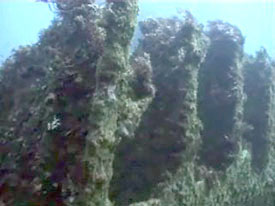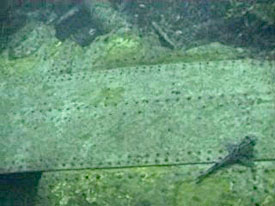Pericles Research Group
Initial Investigation of SS Pericles
Cape Leeuwin Lighthouse in Western Australia
The Pericles Research Group is a loose-knit group of interested people, divers and non-divers, who are slowly and methodically piecing together the full story of the White Star Line’s S.S. Pericles. When launched on December 21, 1907, this four-masted 6,000 IHP twin-screw steamer had room for 100 first class passengers, 400 third class and 150 crew. After completing sea trials in June 1908, the following month SS Pericles set off for Sydney on its maiden voyage. By all accounts it was the most opulent luxury liner servicing Australia in 1908.

SS Pericles of the White Star Line
On March 31, 1910, during its fourth voyage, the S.S. Pericles hit a rock near Cape Leeuwin in South Western Australia, tearing a gash in the hull and sinking bow first over the following two and a half hours. Conditions were fair, and guided by a signal fire lit by the keeper at the Cape Leeuwin lighthouse the passengers and crew all made it to shore in the dozen lifeboats. No trace could be seen of the ship after it sank; yet days later, the ship’s masts could be seen below the surface, leading one historian to speculate the Pericles rolled onto its side and then righted itself underwater.The exact location of the wreck was lost for nearly half a century until it was located and partially salvaged in the 1950’s.

Approximate site location.
Survivors of the wreck scattered worldwide. Some settled within Western Australia (WA), and thirty more returned to Melbourne courtesy of the White Star line, having lost everything. Others went on to London, but overwhelmed by Fremantle residents’ generosity when provided with clothes and board soon after the wrecking, later returned to settle within WA.

Research vessel Jaffa
Tons of goods washed up on shore, an unexpected gift to the pioneers living in the South West. Cartloads of families, towing horses behind them, traipsed down to Black Point from as far away as Wonnerup to gather the bounty.
The question remains unsolved of which rock the vessel actually hit. Officers testified they had set a safe course and were nowhere near the South West Breakers, and Lloyd’s Insurance faced a bill of half a million pounds sterling. The White Star Line would be responsible for the bill if it could be proved that the course was an unsafe one, so stakes were high as the officers walked into the formal hearing. The Navy dispatched a ship with the sole task of finding this “uncharted rock” but to no avail. They concluded that the SS Pericles was on a safe course when it hit an uncharted pinnacle of rock, which then snapped off, and so it was now safe for other vessels to visit Australia.

Large sections of the ship's structure remain.
Today, the formerly 158m long and 19m wide liner rests at a depth of 34m, with ribs exposed and pipes twisted. Lying within sight of the lighthouse, the strong currents and big swells at the junction of the Indian and Southern Oceans protect the wreck from casual divers. Water temperatures range from an almost balmy 15 degrees Celsius in mid-winter, to a virtually tropical 22 degrees in late summer, but the main concern is the remoteness of the site and the strong currents.

A four foot (1.2 meters) shark glides over iron hull plates.
Much of the wreck appears virtually level, though there are plenty of nooks to explore and three massive boilers still stand intact near the engine. The still-standing engine was one of two used to power the SS Pericles up to 14 knots, and was one of the few quadruple expansion engines built before the world turned to steam-turbines.
The wreck is fully protected, so it is strictly no souvenirs, and the challenge now is to map the wreck-site. The Pericles Research Group will use a variety of underwater technology ranging from the simple tape-measure and depth-gauge to stitched photo-mosaics, remote camera units and hand-held underwater video. The size of the wreck-site is simply enormous. Mapping continues as divers explore outwards from the initial reference point of the engine and discover new structures on each dive.

SS Pericles field sketch by Peter Buzzacott
*If you are interested in contributing to the group’s efforts then please e-mail us at reefdiving@eftel.com.au with the subject heading "Pericles."
Return to In The Field home page.





